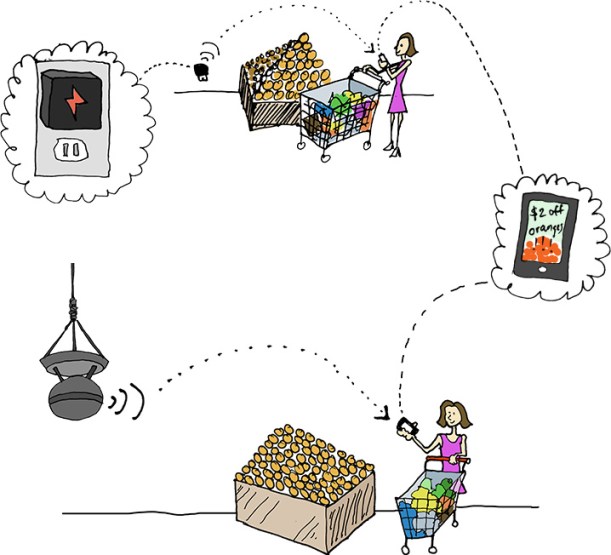
What if your smartphone was actually smart enough to know the exact product you’re standing in front of in a store, without any help from your part? Or what if it could automatically receive offers related to what you’re watching on TV?
[aditude-amp id="flyingcarpet" targeting='{"env":"staging","page_type":"article","post_id":715366,"post_type":"story","post_chan":"none","tags":null,"ai":false,"category":"none","all_categories":"business,media,mobile,","session":"D"}']It’s possible to do those things today, but it requires more work than most brands want to deal with. New York City-based Sonic Notify thinks it has the best solution for marketers and consumers alike.
The company has developed a way to embed content within high-frequency audio, allowing your smartphone to receive relevant offers and notifications simply by “listening” to the sound around you. Sonic Notify also announced today that the U.S. Patent Office has awarded its audio watermarking technology with Patent No. 8,401,569 (it’s currently waiting for two more patents to clear).
AI Weekly
The must-read newsletter for AI and Big Data industry written by Khari Johnson, Kyle Wiggers, and Seth Colaner.
Included with VentureBeat Insider and VentureBeat VIP memberships.
“[Our technology] lets companies talk to consumers right at the point of interaction,” said Sonic Notify chief executive Jonathan Glanz in an interview with VentureBeat.
So, for example, a store could have Sonic Notify’s signal running through its PA system to push a welcome message straight to your phone when you walk in (assuming you’re running the store’s app). Once you’re in an aisle, Sonic Notify’s tiny devices can also send you additional content as you’re deciding between different brands of cereal. The company’s technology can also be embedded within TV commercials or shows to push offers, or to simply note that you’ve seen a specific commercial.
It’s sort of like Google Analytics for the real world, Glanz tells me. Brands will be able to track how consumers interact with their marketing and products right from the beginning (e.g., an ad during prime time TV), right up until the point they buy the product. And of course, it unlocks a wealth of data in between those two interactions as well, like telling brands if you’ve actually scoped out their products within stores.
“We can now show the entire pass of the consumer’s ad user experience,” Glanz said.
I know, it sounds terrifying. Especially since it’s well-positioned to be adopted by retailers, since it costs only $150 to outfit a store with Sonic Notify’s technology, compared with around $10,000 for Wi-Fi consumer tracking solutions.
We’ve already seen similar in-store marketing efforts from companies like ShopKick, which uses in-store devices to deliver offers to your phone. But since Sonic Notify’s core technology spans more than just the retail experience, it could potentially offer brands a wealth of information about consumers.
[aditude-amp id="medium1" targeting='{"env":"staging","page_type":"article","post_id":715366,"post_type":"story","post_chan":"none","tags":null,"ai":false,"category":"none","all_categories":"business,media,mobile,","session":"D"}']
Glanz promises that the offers and notifications will be “extremely targeted” and a “really controlled experience,” and he noted that the company is working with the North American Privacy Commission to prove it’s using consumer data in good faith.
The company has been talking about its technology for more than a year now, but now that it has its first patent locked in, we’ll likely see it popping up in many more locations. Ganz hinted that some deals were in the works with some popular apps and retailers, but he wasn’t able to talk about anything specifically. Not surprisingly, the company is also building up its own ad network, as well as well as a variety of analytics offerings.
It’s not hard to imagine how this sort of technology could be used outside of simple marketing. Ganz tells me that the company was also working on implementing it inside of New York City’s buses, which could ultimately be used to give us a crowd-sourced, real-time map of the bus system’s performance. That project never got off the ground, but expect to see even more creative uses of the company’s tech down the line.
Sonic Notify launched in 2011 and has so far raised around $4.25 million from Raptor Group, A-Grade Investments, and others. Glanz also poured $400,00 of his own funds to get the company off the ground.
[aditude-amp id="medium2" targeting='{"env":"staging","page_type":"article","post_id":715366,"post_type":"story","post_chan":"none","tags":null,"ai":false,"category":"none","all_categories":"business,media,mobile,","session":"D"}']
VentureBeat's mission is to be a digital town square for technical decision-makers to gain knowledge about transformative enterprise technology and transact. Learn More
